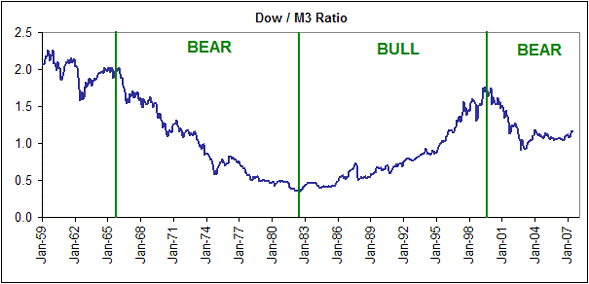|
|||
Cutting Through the BullSteve Saville
Equities are claims on real assets and the cash flows that these assets generate. As a result, the nominal prices of equities can be, and often are, boosted when excessive growth in the supply of money (inflation) causes the currency to lose purchasing power. To avoid being hoodwinked by the effects of inflation we therefore need to find ways to monitor the stock market's REAL trend (the trend after the effects of inflation are properly accounted for). After all, if the nominal price of an investment rises by 10% during a period when the value of the currency in which the investment is priced falls by 20%, then despite the nominal price gain the owner of this investment will suffer a reduction in real wealth. As we've explained many times over the years, one of the best ways to see what's really happening to the stock market is to look at long-term valuation trends. In particular, we can effectively remove the distorting effects of inflation from our interpretation of the stock market's long-term trend by defining a secular bull market as a generational (15-25 year) trend toward higher valuations and defining a secular bear market as a generational trend toward lower valuations. One reason is that lower valuations (lower multiples of earnings, sales, book value and dividends) are invariably assigned to stocks during periods when a large chunk of corporate profit growth is perceived by the investment community to be the result of inflation. With the above definitions of the secular trend in hand, a look at what has happened to the US stock market's average valuation over the past 80 years will reveal that: a secular bear market commenced in 1929; a secular bull market commenced in the mid-1940s; a secular bear market commenced in the mid-1960s; a secular bull market commenced in the early-1980s; and a secular bear market commenced during 1999-2001. Interestingly, but not surprisingly for anyone who understands the nature of gold, when the US stock market's performance is measured in gold terms its long-term trends roughly line-up with the aforementioned long-term valuation trends. Therefore, secular trends in the US stock market can also be seen by looking at long-term charts of the Dow/gold ratio. Now, in previous commentaries we've used charts to illustrate the links between long-term valuation trends, trends in the Dow/gold ratio, and secular bull/bear markets. Such charts are, in essence, ways of viewing the stock market's real (inflation-adjusted) performance over the long-term*. It recently occurred to us, however, that an important long-term chart that we have never looked at in the TSI commentaries is the Dow Industrials Index adjusted for changes in the total supply of money. In other words, it occurred to us that we've shown surrogates for the inflation-adjusted Dow on many occasions but have never shown the actual inflation-adjusted Dow. We are about to remedy this omission. Below is a chart of the Dow/M3 ratio (the Dow Industrials Index divided by the total US money supply). Unfortunately, we don't have M3 data prior to 1959, but the data we do have is enough to tell us that long-term trends in the inflation-adjusted Dow mesh quite well with the valuation and Dow/gold trends discussed above. The bottom line is that whichever way we look at it we see that US equities are presently about 7 years into a secular bear market.  Before leaving the subject of how money-supply growth can create the appearance of a bull market where no bull market exists it is appropriate to address a related issue: the general misconception about the relationship between capitalism and rising asset prices. It has been mentioned in several quarters that the global rise in equity prices indicates the spread of capitalism. The implication, here, is that capitalism leads to higher asset prices. Well, we've come across a lot of analytical hogwash in our time but this comes close to 'taking the cake'. Capitalism has many characteristics, but at the end of the day it is really just an economic system based on the total and consistent application of property rights. The main driver of the upward trend in nominal prices, on the other hand, is government-sponsored inflation; and government-sponsored inflation is a gross VIOLATION of property rights (inflation is a form of theft because it reduces peoples' real monetary savings just as effectively as if a portion of these savings were being physically stolen). Furthermore, when we look at what has happened to the stock markets of various countries around the world we can actually observe an INVERSE correlation between stock market gains and the extent to which property rights are upheld. Zimbabwe is the most blatant example of this inverse correlation, but China and Russia -- two countries that have provided equity market investors with phenomenal gains over the past few years -- are also good examples. On a superficial level it may appear as if capitalism is thriving in China and Russia, but a property right that's likely to vanish the moment you utter a word against the government is not a genuine right at all. Capitalism lays the foundation for strong REAL growth whereas rapid across-the-board gains in asset prices are generally the result of inflation. Don't confuse one with the other. *Note that when creating an inflation-adjusted picture it makes absolutely no sense to use the price indices reported by the government because these price indices are meaningless. Steve Saville Regular financial market forecasts and analyses are provided at our web site: We aren't offering a free trial subscription at this time, but free samples of our work (excerpts from our regular commentaries) can be viewed at: http://tsi-blog.com Saville Archives |
